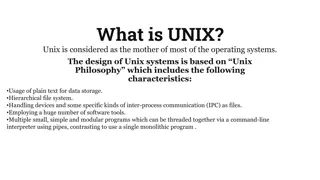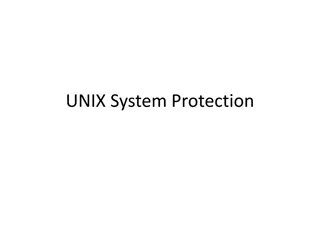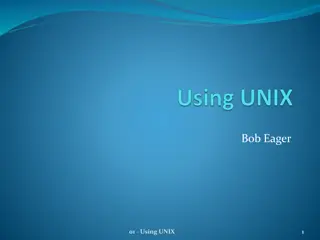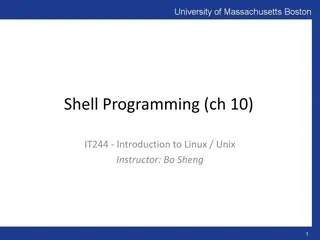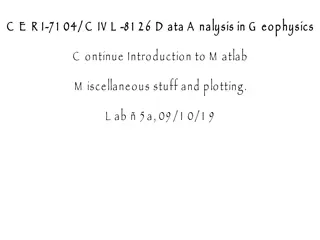Introduction to Bash Shell Programming
Learn about the fundamentals of shell programming in Unix/Linux systems, including the role of the shell as an interface between users and the operating system. Understand the components of a shell, such as the kernel, and explore different types of shells like Bourne Shell and C Shell. Discover how
6 views • 17 slides
Pronoun Placement with Commands in English and Spanish
Understanding pronoun placement in commands is crucial in both English and Spanish. In English, pronouns are placed after the verb in both affirmative and negative commands. However, in Spanish, affirmatives attach pronouns while negatives place them in front of the verb. Examples and accent rules a
1 views • 5 slides
Understanding Android Debug Bridge (ADB) Commands
Android Debug Bridge (ADB) is a powerful command-line utility used to communicate with Android devices. It allows you to perform various tasks such as listing connected devices, installing apps, transferring files, taking screenshots, and more. Learn about ADB client-server architecture, connecting
1 views • 16 slides
Introduction to Unix-like Systems and Shell Interaction
Unix-like systems, such as Linux, Android, iOS, and macOS, are prevalent in various devices. The Unix shell acts as an intermediary between users and the operating system, allowing for program execution and process management. Secure Shell (SSH) and X Window System enable remote machine connections
4 views • 19 slides
Understanding CP and MV Commands in Unix/Linux
CP and MV commands in Unix/Linux are essential for copying and moving files or directories. CP is used to copy files with various options for different scenarios, while MV is used to move or rename files. Learn examples and practical usage of these commands to efficiently manage your files on the te
0 views • 5 slides
Understanding UNIX and Linux Operating Systems
UNIX, known as the mother of most operating systems, follows a design philosophy rooted in plain text data storage, hierarchical file systems, and modular programs. The UNIX kernel controls system functions, while Linux, a Unix-like OS, operates as a free and open-source alternative developed from s
2 views • 4 slides
On the Shoulders of Giants: Harnessing Powerful Commands in Stata for Efficient Coding
Stata users can enhance their coding efficiency by utilizing powerful commands that are often overlooked. This presentation showcases examples of commands that can streamline coding work, ranging from interactive use to supporting long programs. By leveraging these commands, users can avoid reinvent
0 views • 51 slides
Introduction to UNIX Programming Languages and Program Development
Discover the fundamentals of UNIX operating system, its significance in modern computing, directory structures, pathnames, and the role of CPU in computer systems. Learn why understanding UNIX can be essential for efficient program development and resource management. Explore the distinction between
0 views • 42 slides
The Power of Unix Command Line Basics for Text Processing in Bioinformatics
Unix Shell commands such as sort, cut, uniq, join, paste, sed, grep, awk, wc, diff, comm, and cat are essential for text processing in bioinformatics. These tools allow seamless manipulation of text data without the need for intermediate files, making file processing efficient and powerful. By pipin
0 views • 19 slides
Basic Linux Commands Overview for Embedded Programming and Robotics
Embedded Programming and Robotics Lesson 13 provides an introduction to basic Linux commands such as man, ls, cd, cp, and more. Understanding these commands is essential for interacting with the operating system on devices like Raspberry Pi. The lesson also covers important concepts like superuser p
0 views • 17 slides
Understanding UNIX System Permissions and User Terminology
Explore the concept of UNIX system permissions, including discretionary access control (DAC) model, user terminology, file/directory access, access permission modes, categories of users, and checking permissions using examples. Learn about user IDs, groups, superuser privileges, ownership, access mo
0 views • 24 slides
Overview of UNIX System Protection
UNIX System Protection focuses on ensuring security and access control mechanisms within the UNIX operating system. Developed in 1969 by Dennis Ritchie and Ken Thompson at AT&T Bell Labs, UNIX features design elements like a portable API, protection rings, kernel processes, and a trusted computing b
0 views • 12 slides
Understanding Unix Shells: A Comprehensive Overview
Explore the fundamentals of Unix shells, including their role as an interface between the Unix kernel and users, different shell types like Bourne, Korn, and Bourne-again shells, shell startup files, environment variables, and more. Learn how shells interpret and run commands, manage aliases, and co
0 views • 40 slides
CS252 Systems Programming Course Overview
This course overview covers topics such as C programming review, Unix basics, Unix systems programming, and grading details. The course includes labs on C/C++ programming, Unix shell scripting, and writing your own shell. Communication is emphasized through Piazza for questions/answers and Blackboar
0 views • 41 slides
Understanding Filesystems and Inodes in UNIX
Delve into the complexities of filesystems such as FFS and LFS, exploring concepts like i-nodes, ownership, permissions, and indirect blocks. Learn about the structure of UNIX inodes, path searching, caching, read-ahead optimization, and the limitations of the original UNIX filesystem. Unravel the i
0 views • 24 slides
Dyalog APL on UNIX - Development Environment Overview
Discover the supported platforms for Dyalog APL on UNIX, including AIX and various Linux distributions. Learn about driving APL on UNIX, using PuTTY for Windows clients, configuring terminal windows, and running TryAPL as a service. Get insights on setting up Dyalog APL on Linux and explore keyboard
1 views • 39 slides
Essential Unix Commands for Beginners
Learn essential Unix commands such as pwd, ls, cd, mkdir, and man, along with their functionalities and usage in navigating the Unix file system effectively. Understand the basics of directories, file structures, and how to get help using the command line interface.
0 views • 18 slides
Introduction to the Command Line: Basic Commands and Unix Systems
This material provides an overview of fundamental commands in Unix systems, applicable to both Unix and Linux operating systems. It covers topics like directory structure, text file manipulation, file permissions, redirections, pipes, wildcards, and more. Learn about the nature of Unix systems, how
0 views • 43 slides
Introduction to Using UNIX: A Comprehensive Guide
Explore the rich history and practical benefits of using UNIX systems. Learn about the UNIX user interface, the significance of command line interactions, the philosophy of small programs, and the evolution of graphical interfaces. Discover why mastering UNIX skills is valuable for computing student
0 views • 29 slides
Understanding UNIX Operating System
UNIX is a versatile operating system that enables multi-user access, multitasking, and portability across various computing environments. It serves as the foundation for many modern operating systems and has influenced concepts incorporated in Microsoft Windows and DOS. The UNIX system comprises dis
0 views • 51 slides
Guide to Giving Negative Commands in Spanish
Learn how to effectively communicate what not to do in Spanish with negative commands. Understand the different forms of negative commands for -AR, -ER/-IR verbs, irregular verbs, direct object pronouns, stem-changing verbs, and verb forms ending in -CAR, -GAR, -ZAR. Master the rules and exceptions
0 views • 12 slides
Understanding the Imperative Mood in Language
The imperative mood focuses on giving commands without reference to different time frames. It entails direct statements with the understood recipient mainly being 'you.' Commands in the singular, informal form involve dropping the 's' from the second person singular verb, both in affirmative and neg
0 views • 19 slides
Understanding Negative -T Commands in Spanish
Negative -T commands in Spanish are used to tell someone what not to do. These commands are often directed at friends or familiar individuals. Forming negative -T commands involves starting with the YO form in the present tense, dropping the O for -ER/-IR verbs, adding -ES for -AR verbs, and includi
0 views • 50 slides
Exploring Unix Input and Output Topics in CS.105
Dive into the Unix I/O philosophy, understanding pathnames, conventions, and file structures. Learn how Unix revolutionized file handling with its unified approach and discover the power of accessing files, reading/writing, pipes, and filters. Gain insights into Unix file conventions and the flexibi
0 views • 29 slides
Introduction to Linux: Course Overview and Objectives
This introduction to Linux course provides a comprehensive overview of operating systems, including the history, variations, user interface, and essential commands. The course is designed with lectures, labs, and exercises to help participants gain a better understanding of Linux and its practical a
0 views • 77 slides
Introduction to Shell Programming in Linux/Unix with Vim and Control Flow Commands
Explore the basics of shell programming in Linux/Unix, including Vim commands for editing files, control flow commands like if-then statements, and examples of executing commands with built-in utilities. Learn how to handle arguments, read input, and implement conditional logic in scripts.
0 views • 47 slides
Introduction to Shell Scripting in UNIX and Network Programming
Shell scripts in UNIX and network programming provide a powerful way to automate tasks, simplify recurring operations, and enhance system administration. They leverage variables, decision-making control, looping abilities, and function calls to streamline processes. With essential features like file
0 views • 32 slides
Process Management in UNIX Systems
Explore the intricate process management mechanisms in UNIX operating systems, covering the suspension, activation, and destruction of processes along with resource allocation and priority handling. Delve into the scheduling intricacies of UNIX environments for optimal performance.
0 views • 18 slides
Exploring SFTP and UNIX Topics for Web Hosting
Explore how to work with files on your web hosting site, upload an index page, understand the public_html directory, learn about SFTP (Secure File Transfer Protocol), and basic UNIX commands for navigating directories and connecting to web servers.
0 views • 10 slides
Introduction to Data Analysis in Geophysics Using UNIX
Learn how to use UNIX commands such as pipes and xargs in geophysics data analysis. Discover how to manipulate file lists, search for specific strings in files, and run programs on file names efficiently using xargs in a UNIX environment.
0 views • 34 slides
Introduction to UNIX Commands and Basic C Programming Exercises
This content guide provides step-by-step instructions on downloading, unpacking, and using examples in UNIX environment, connecting to a university UNIX account from Windows using Putty, logging in with UPI and password, and running basic C programming exercises. It also covers basic Linux commands
0 views • 13 slides
Essential UNIX and C Programming Tutorial for Beginners
Master the basics of accessing University UNIX accounts, downloading and unpacking files, compiling and running C programs, and executing basic Linux commands with this comprehensive tutorial. Learn how to navigate directories, compile code, and execute programs with step-by-step instructions and vi
0 views • 13 slides
Understanding UNIX Operating System and File System
UNIX is a powerful operating system developed in the 1960s that forms the basis for modern systems like Linux. It manages hardware communication for users and programs. The file system organizes files in a hierarchical structure, with directories acting as folders. Learn about directories, subdirect
0 views • 19 slides
Understanding Unix Process Management in Computer Systems II
This overview delves into the creation, termination, memory layout, and dynamic memory management of Unix processes in Computer Systems II. It covers the distinctions between code, executables, and processes, the memory layout of Unix processes, management of heap memory using malloc and free functi
0 views • 27 slides
Introduction to MATLAB Commands for Data Analysis in Geophysics
Learn how UNIX commands work in MATLAB, differentiate between MATLAB and UNIX commands, utilize MATLAB's help function, explore topics available for help, access help on individual commands, and create constant matrices in MATLAB for data analysis in geophysics.
0 views • 28 slides
Intermediate Linux Workshop Overview
This intermediate Linux workshop covers various topics including input, output, pipes, processes, compiling Unix software packages, symbolic and hard links, environment variables, security, and ECC policies. It also explains CougarNet authentication for accessing engineering Linux systems, setting u
0 views • 34 slides
Mastering UNIX Text Processing: Tips and Tricks
Explore the world of UNIX text processing through a comprehensive guide covering essential commands, efficient workflows, and powerful combinations. Learn how UNIX commands streamline tasks, eliminate redundant code, and enhance productivity. Discover the art of piping, output redirection, and utili
0 views • 48 slides
Overview of UNIX and Linux Operating Systems
The UNIX brand encompasses a range of powerful multitasking, multiuser operating systems used by various organizations to develop IT technologies. UNIX internals consist of kernel space and user space, with programs accessing system services rather than hardware directly. The Unix filesystem is a ke
0 views • 36 slides
Introduction to Basic UNIX Usage and Network Programming
In this course, you will learn the fundamentals of UNIX usage and network programming. Topics covered include basic UNIX commands, file system structure, UNIX shell functionalities, command line structure, and essential commands like passwd, ls, more, logout, date, and man. Understanding the hierarc
0 views • 31 slides
Introduction to UNIX System and Homework Assignment in CS 240
Learn about connecting to the CS department's UNIX system, setting up accounts, using SSH clients on Windows, Mac, and Linux, navigating the filesystem, and performing commands in the command line interface. Get started with your CS 240 assignments effectively.
0 views • 19 slides





